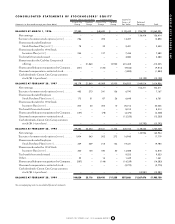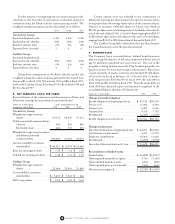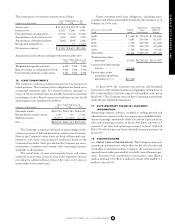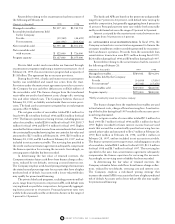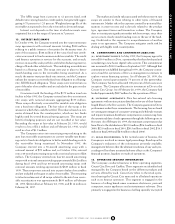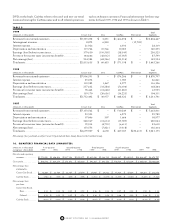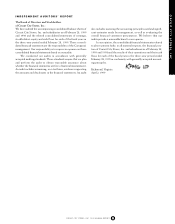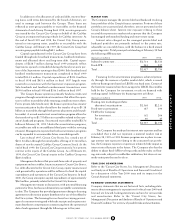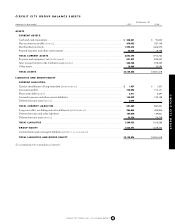CarMax 1999 Annual Report Download - page 44
Download and view the complete annual report
Please find page 44 of the 1999 CarMax annual report below. You can navigate through the pages in the report by either clicking on the pages listed below, or by using the keyword search tool below to find specific information within the annual report.
Receivables relating to the securitization facilities consist of
the following at February 28:
(Amounts in thousands)
1999 1998
Managed receivables ....................... $2,957,132 $2,749,793
Receivables/residual interests held
by the Company:
For sale ....................................... (39,948) (44,622)
For investment............................ (161,996) (203,921)
Net receivables sold......................... $2,755,188 $2,501,250
Net receivables sold
with recourse.............................. $ 322,000 $ 726,000
Program capacity............................. $3,127,000 $3,075,000
Private-label credit card receivables are financed through
securitization programs employing a master trust structure. As of
February 28, 1999, this securitization program had a capacity of
$1.38 billion. The agreement has no recourse provisions.
During fiscal 1998, a bank card master trust securitization
facility was established and issued two series from the trust.
Provisions under the master trust agreement provide recourse to
the Company for any cash flow deficiencies on $322 million of
the receivables sold. The finance charges from the transferred
receivables are used to fund interest costs, charge-offs, servicing
fees and other related costs. The Company believes that as of
February 28, 1999, no liability existed under these recourse provi-
sions. The bank card securitization program has a total program
capacity of $1.75 billion.
The net gain on sales of receivables totaled $2.3 million for
fiscal 1999, $21.8 million for fiscal 1998 and $3.2 million for fiscal
1997. The finance operation’s servicing revenue, including gains on
sales of receivables, totaled $200.6 million for fiscal 1999, $195.7
million for fiscal 1998 and $197.0 million for fiscal 1997. Rights
recorded for future interest income from serviced assets that exceed
the contractually specified servicing fees are carried at fair value and
amounted to $27.3 million at February 28, 1999, $25.0 million at
February 28, 1998, and $3.2 million at February 28, 1997, and are
included in net accounts receivable. The servicing fees specified in
the credit card securitization agreements adequately compensate
the finance operation for servicing the accounts. Accordingly, no
servicing asset or liability has been recorded.
In determining the fair value of retained interests, the
Company estimates future cash flows from finance charge collec-
tions, reduced by net defaults, servicing cost and interest cost.
The Company employs a risk-based pricing strategy that increases
the stated annual percentage rate for accounts that have a higher
predicted risk of default. Accounts with a lower risk profile also
may qualify for promotional financing.
The private-label card programs, excluding promotional bal-
ances, range from 21 percent to 24 percent APR, with default rates
varying based on portfolio composition, but generally aggregat-
ing from 6 percent to 10 percent. Principal payment rates vary
widely both seasonally and by credit terms but are in the range of
9 percent to 12 percent.
The bank card APRs are based on the prime rate and generally
range from 7 percent to 22 percent, with default rates varying by
portfolio composition, but generally aggregating from 8 percent to
12 percent. Principal payment rates vary widely both seasonally
and by credit terms but are in the range of 5 percent to 8 percent.
Interest cost paid by the master trusts varies between series
and ranges from 5.0 percent to 6.3 percent.
(B) AUTOMOBILE LOAN SECURITIZATION:
In fiscal 1996, the
Company entered into a securitization agreement to finance the
consumer installment credit receivables generated by its automo-
bile loan finance operation. Proceeds from the automobile loan
securitization transaction were $271 million during fiscal 1999,
$123 million during fiscal 1998 and $58 million during fiscal 1997.
Receivables relating to the securitization facility consist of
the following at February 28:
(Amounts in thousands)
1999 1998
Managed receivables.............................. $589,032 $291,294
Receivables held by the Company:
For sale.............................................. (14,690) (5,816)
For investment* ................................ (35,342) (17,478)
Net receivables sold............................... $539,000 $268,000
Program capacity................................... $575,000 $300,000
*Held by a bankruptcy remote special purpose company
The finance charges from the transferred receivables are used
to fund interest costs, charge-offs and servicing fees. A restructur-
ing of the facility during fiscal 1997 resulted in the recourse provi-
sions being eliminated.
The net gain on sales of receivables totaled $7.9 million for
fiscal 1999, $3.7 million for fiscal 1998 and $3.1 million for fiscal
1997. Rights recorded for future interest income from serviced
assets that exceed the contractually specified servicing fees are
carried at fair value and amounted to $14.7 million at February 28,
1999, $6.8 million at February 28, 1998, and $3.1 million at
February 28, 1997, and are included in net accounts receivable.
The finance operation’s servicing revenue, including gains on sales
of receivables, totaled $28.2 million for fiscal 1999, $11.2 million
for fiscal 1998 and $8.7 million for fiscal 1997. The servicing fee
specified in the auto loan securitization agreement adequately
compensates the finance operation for servicing the accounts.
Accordingly, no servicing asset or liability has been recorded.
In determining the fair value of retained interests, the
Company estimates future cash flows from finance charge collec-
tions, reduced by net defaults, servicing cost and interest cost.
The Company employs a risk-based pricing strategy that
increases the stated APR for accounts that have a higher predicted
risk of default. Accounts with a lower risk profile also may qualify
for promotional financing.
42 CIRCUIT CITY STORES, INC. 1999 ANNUAL REPORT



